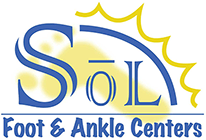The Importance of Blood Flow in Lower Extremities
The loss of sufficient blood flow to the feet and legs can be devastating. Arterial blood flow provides oxygen to the tissues, which is necessary to maintain the health of all tissue types – skin, bones, muscles, tendons, etc. Without enough oxygen, the tissues of the feet and legs will begin to fail. This can lead to a multitude of issues depending on the severity of the problem including pain, difficulty walking, inability to heal, and, in extreme cases, gangrene.
Identifying the Risks: When Circulation Becomes a Concern
It's very important to monitor the circulation in your lower extremities, especially if you have risk factors for poor circulation like diabetes, hypertension, kidney disease, and/or a history of smoking (to name a few). How do you know that your circulation is adequate? There are a few things you can look for, but please keep in mind that none of these is necessarily bad (or good) by itself.
Key Signs of Adequate Circulation in Feet and Legs
- Skin temperature – the temperature of the skin on your feet and toes should be the same as the skin on other parts of your body.
- Hair – you may not like the hair on your toes, but having it is usually an indication of decent blood flow.
- Toenails – having toenails that grow nearly as fast as your fingernails is a good sign (even if you get tired of trimming them!). Slow-growing nails or having thick and discolored nails sometimes indicate a lack of circulation.
- Skin color and thickness - changes in skin color and/or thinning of the skin are often indicative of circulatory changes.
Taking Action: When to Check Your Circulation
What should you do? If you have risk factors and/or you notice any of the issues mentioned above, you should get your circulation checked ASAP! Your podiatrist (if you don’t have one you should get a good one!) should be able to do a few simple, quick, and painless tests to assess the circulation in your legs and feet. In our office, we use the SmartABI system, which gives us a report about your blood flow.
The Role of a Podiatrist in Assessing Circulation
What happens next? The most important thing is that now we’ve checked it out. If you show signs of poor circulation, we can take the proper steps to intervene. If your circulation is adequate or you just have risk factors, we can simply monitor every few months to make sure nothing is getting worse.
Next Steps After Circulation Evaluation
The most important thing is that you’re aware of and have checked the circulation in your feet. Likely this will put your mind at ease, but if there are any problems they will be identified immediately. Take control of your foot health and call the podiatrist today! (562) 433-0478











